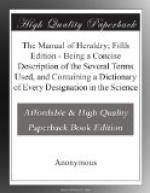It would be utterly impossible to give either a graphic or written description of all the charges in a book of this size or even in one ten times as large. The sun, moon, stars, comets, meteors, &c., have been introduced to denote glory, grandeur, power, &c.; lions, leopards, tigers, serpents, stags, have been employed to signify courage, strength, prudence, swiftness, &c.
The application to certain exercises, such as war, hunting, music, fishing, &c., has furnished lances, swords, armour, musical instruments, architecture, columns, chevrons, builders’ tools, &c. Human bodies, or distinct parts of them, are frequently used as charges. Trees, plants, fruits, and flowers have also been admitted to denote the rarities, advantages, and singularities of different countries.
The relation of some creatures, figures, &c. to particular names has been a fruitful source for variety of arms. Thus, the family of Coningsby bears three conies; of Arundel, six swallows; of Corbet, a raven; of Urson, a bear; of Camel, a camel; of Starky, a stork; of Castleman, a castle triple-towered; of Shuttleworth, three weaver’s shuttles. Hundreds of other names might be given, but the before-mentioned will be sufficient to show the reader the origin of many singular charges in coats of arms.
Not only were natural and artificial figures used, but the lack of information on Zoology and other branches of Natural History led to the introduction of fabulous animals, such as dragons, griffins, harpies, wiverns, &c. A great number of charges, indeed most of them that require explanation, will be found in the Dictionary of Heraldic Terms, which will prevent the necessity of describing them more at large in this part of the book.




